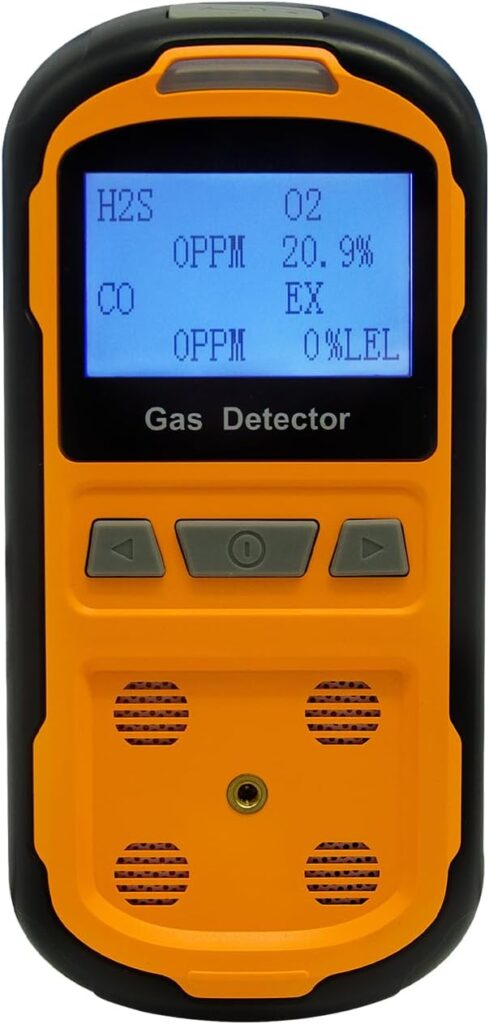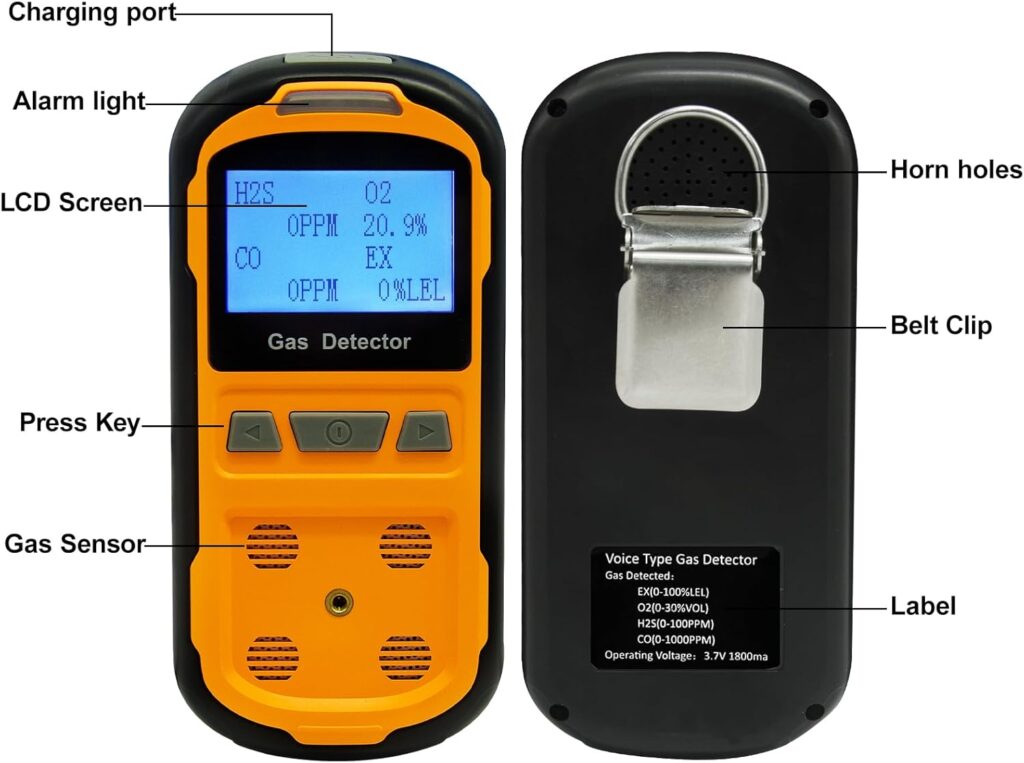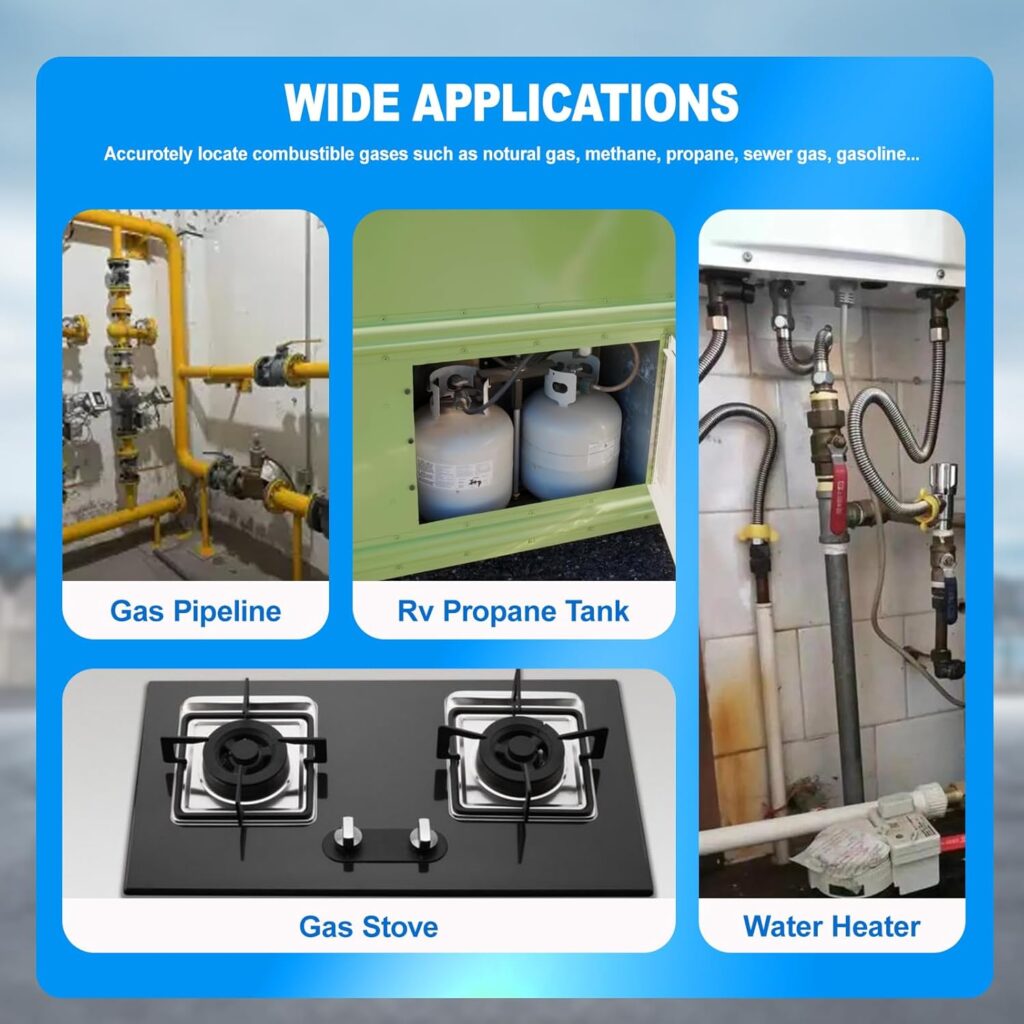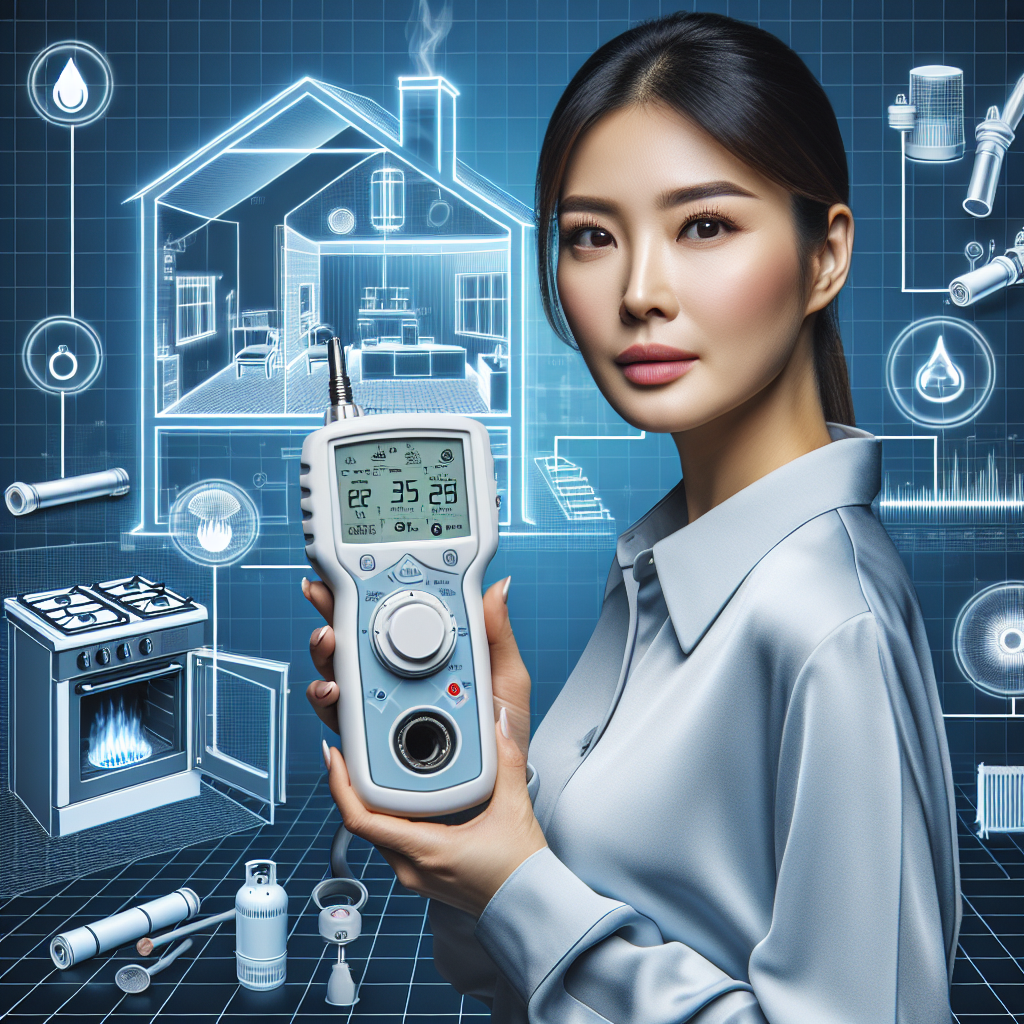Enhancing Home Inspections Safety with Gas Detector Technology: Your peace of mind, our top priority.
Gas leaks can pose significant risks in residential properties, making it crucial for home inspectors to prioritize safety during their assessments. With the advancements in gas detector technology, these professionals now have a powerful tool at their disposal to ensure a safe working environment and protect homeowners from potential hazards. This article will explore how gas detector technology enhances home inspections’ safety by swiftly identifying gas leaks and enabling prompt action to mitigate any dangers associated with them.

Introduction to Gas Detector Technology for Home Inspections Safety
Home inspections are an essential part of the home buying process, providing potential homeowners with a comprehensive evaluation of a property’s condition. From checking electrical systems to examining structural integrity, inspectors play a vital role in ensuring the safety and functionality of a house. However, one aspect that is often overlooked during these inspections is the presence of harmful gases, which can pose significant health risks if not properly addressed. In recent years, gas detector technology has emerged as a valuable tool in enhancing home inspections safety by alerting inspectors to the presence of potentially hazardous gases.

One of the primary concerns when it comes to gas detection during home inspections is carbon monoxide (CO). This odorless and colorless gas is produced by incomplete combustion and can accumulate in enclosed spaces such as basements or garages. High levels of CO can be fatal if left undetected. Traditional methods for detecting CO involve using handheld devices that provide real-time measurements; however, these methods are often time-consuming and may miss certain areas within a property.
Gas detector technology offers an innovative solution to this problem by providing continuous monitoring capabilities throughout the entire duration of an inspection. These detectors are equipped with sensors capable of detecting multiple types of gases simultaneously, including CO. By strategically placing these devices around a property during an inspection, potential hotspots for hazardous gas accumulation can be identified promptly.
In addition to carbon monoxide detection, gas detectors also serve as invaluable tools for identifying other potentially harmful gases commonly found in homes. For instance, natural gas leaks pose significant risks due to their flammable nature and ability to displace oxygen within enclosed spaces. A well-placed gas detector can quickly alert inspectors about any leaks from appliances such as stoves or water heaters before they escalate into more dangerous situations.
Furthermore, some newer models come equipped with advanced features such as wireless connectivity and data logging capabilities. This allows inspectors to remotely monitor gas levels and collect data over an extended period. By analyzing this data, trends in gas levels can be identified, providing insights into potential long-term issues that may require attention.
Gas detector technology not only enhances the safety of home inspections but also provides peace of mind for both inspectors and prospective homeowners. By employing these devices, inspectors can confidently assure clients that their properties have been thoroughly evaluated for any potential gas-related hazards. This added level of diligence reinforces trust between buyers and sellers, leading to smoother transactions within the real estate market.
In conclusion, gas detector technology has proven to be a game-changer when it comes to enhancing home inspections safety. These devices offer continuous monitoring capabilities for gases such as carbon monoxide and natural gas leaks throughout the duration of an inspection. With advanced features like wireless connectivity and data logging, inspectors can analyze trends in gas levels over time, ensuring comprehensive evaluations are conducted. By integrating this technology into their workflow, home inspectors can deliver superior service while mitigating potential health risks associated with harmful gases found within residential properties
Benefits of Using Gas Detectors in Home Inspections
Home inspections are an integral part of the real estate industry. They provide potential buyers with a comprehensive evaluation of a property’s condition, including identifying any safety hazards that may be present. One such hazard that is crucial to detect and address during home inspections is the presence of gas leaks.
Gas leaks can pose significant risks to homeowners and their families, including the potential for explosions or fires. Therefore, it is imperative for home inspectors to have access to reliable and accurate gas detector technology in order to enhance safety during their assessments.

Using gas detectors in home inspections offers several benefits. Firstly, these devices enable inspectors to identify the presence of various gases accurately. Natural gas, propane, carbon monoxide – these are all potentially dangerous gases that can leak within a property without being readily noticeable by sight or smell alone. Gas detectors provide an additional layer of protection by detecting even minute traces of these substances.
Moreover, incorporating gas detection technology into home inspections allows for more thorough examinations of potential hazards throughout a property. Unlike humans who rely on sensory cues such as smell or visual indications like foggy windows, gas detectors offer objective measurements and indicators of danger levels related to combustible gases and carbon monoxide emissions.
In addition to improving accuracy in detecting hazardous gases within homes, using gas detectors during inspections also saves time and money by expediting the identification process. Traditional methods relying solely on manual inspection techniques could be time-consuming due to reliance on subjective observations rather than precise data collection offered by specialized instruments like gas detectors.
Furthermore, modern advancements in gas detector technology have made these devices highly portable and user-friendly for both professional inspectors and homeowners alike. These compact gadgets can easily be carried around properties during inspections without causing any disruptions or inconveniences.
Another benefit lies in the educational aspect provided by utilizing this technology during home inspections – not only do professionals gain insights into assessing properties safely but they also contribute towards raising awareness among homeowners. By pointing out potential gas leak risks and explaining the importance of preventive measures, inspectors help homeowners prioritize safety and understand the significance of regular inspections.
Moreover, the integration of gas detectors in home inspections aligns with contemporary sustainability efforts. Given that undetected leaks can lead to significant energy waste, incorporating this technology aids in identifying areas where improvements can be made to enhance overall energy efficiency. Additionally, it allows for prompt remedial actions when necessary, reducing environmental impact and potential health hazards associated with prolonged exposure to harmful gases.
In conclusion, using gas detector technology during home inspections offers numerous benefits that contribute towards enhancing safety standards within properties. From accurately detecting dangerous gases like natural gas or carbon monoxide to expediting the identification process while saving time and money – these devices are invaluable tools for professional inspectors aiming at ensuring secure living environments for prospective buyers. Furthermore, their portability and user-friendly nature make them convenient gadgets not only for professionals but also for homeowners who seek to prioritize safety within their properties. Ultimately, by integrating gas detectors into home inspections protocols, we actively contribute towards raising awareness about potential hazards as well as fostering sustainable practices through better energy management within residential buildings.
Common Types of Gases Detected by Gas Detectors in Homes
Gas detectors play a crucial role in ensuring the safety of homes during inspections. These devices are designed to detect the presence of various gases that could pose health risks or potentially lead to dangerous situations. Understanding the common types of gases detected by gas detectors is essential for both home inspectors and homeowners.
One of the most common types of gas detected by these devices is carbon monoxide (CO). This odorless and colorless gas can be produced by faulty appliances, such as furnaces, water heaters, or stoves. Inhaling high levels of carbon monoxide can lead to severe health complications, including organ damage or even death. Gas detectors equipped with electrochemical sensors are particularly effective at detecting carbon monoxide concentrations accurately.
Another gas commonly detected by gas detectors is natural gas (methane), which is widely used for heating and cooking purposes in households. While natural gas itself does not have a distinct smell, an odorant called mercaptan is added to it for easy detection in case of leaks. However, relying solely on smell may not always be sufficient; hence having a reliable methane detector becomes imperative during home inspections.
Propane (LPG) is yet another type of flammable gas often found in homes using propane-fueled appliances such as grills or generators. Propane leaks can occur due to damaged pipes or faulty connections, leading to potential fire hazards if left undetected. Equipping oneself with a propane detector ensures immediate detection before any accidents happen.
Apart from these more well-known gases, some less commonly encountered but equally dangerous ones should also be considered during home inspections. Radon is one such hazardous substance that seeps into houses through cracks in foundations or walls from surrounding soil and rocks containing uranium deposits. Continuous exposure to radon increases the risk of lung cancer significantly over time; thus detecting its presence through specialized radon detectors plays a vital role in ensuring long-term safety.
Volatile organic compounds (VOCs) are gases emitted from various sources such as cleaning products, paints, or building materials. While some VOCs have noticeable odors, others are odorless and can cause health issues like headaches, nausea, or eye irritation. Utilizing gas detectors equipped with photoionization sensors allows for effective detection of these harmful compounds during home inspections.
It is worth mentioning that gas detectors not only detect specific types of gases but also monitor their levels to ensure early detection of any potentially dangerous situations. Most modern gas detectors provide visual and audible alarms when the gas concentration reaches a certain threshold, alerting both inspectors and homeowners immediately.
In conclusion, understanding the common types of gases detected by gas detectors is crucial for enhancing home inspections’ safety. Carbon monoxide, natural gas (methane), propane (LPG), radon, and volatile organic compounds (VOCs) are among the most important substances to be monitored during inspections. Investing in reliable gas detector technology equips professionals with the tools needed to identify potential hazards accurately and take appropriate measures promptly. By incorporating these devices into home inspections practices more consistently, we can create safer living environments for all homeowners while mitigating potential risks effectively.
How to Choose the Right Gas Detector for Home Inspections

Gas leaks in homes can pose a significant risk to the health and safety of occupants. These leaks can lead to fires, explosions, or even carbon monoxide poisoning. Therefore, it is crucial for home inspectors to have the right tools at their disposal to detect and identify gas leaks during inspections. One such tool that has gained popularity in recent years is the gas detector.
Gas detectors are devices designed to detect the presence of gases in the air. They work by measuring specific parameters such as concentration levels or changes in temperature, pressure, or humidity. In home inspections, gas detectors are used primarily to detect combustible gases like methane (natural gas) and propane.
Choosing the right gas detector for home inspections requires careful consideration of several factors. Firstly, it is essential to determine which type of gas you need to detect. While most gas detectors on the market today are multi-gas detectors capable of detecting various gases simultaneously, some models specialize in detecting specific types of gases.
Next, consider whether you want a portable or fixed gas detector. Portable models allow for greater flexibility during inspections as they can be carried around easily from one room to another. On the other hand, fixed models provide continuous monitoring and can be installed strategically throughout a property.
Accuracy is paramount when selecting a gas detector for home inspections. Look for models with high accuracy ratings and low false-positive rates. The sensitivity level should be adjustable so that you can fine-tune it according to your needs.
Another important factor when choosing a gas detector is its response time – how quickly it detects and alerts users about potential hazards. A faster response time ensures prompt action can be taken if there is indeed a leak present.
Additionally, consider the durability and reliability of the device before making your purchase decision; opt for well-known brands that offer warranties and good customer support services.
Moreover, pay attention to battery life since longer battery life means less downtime during inspections. Look for devices with rechargeable batteries or ones that offer extended battery life through energy-efficient technologies.
Furthermore, it is beneficial to choose a gas detector with additional features that can enhance the safety and efficiency of your home inspections. For example, some models come equipped with data logging capabilities, which allow you to record and analyze gas levels over time. This feature can be particularly useful when conducting repeat inspections or monitoring areas prone to frequent leaks.
Additionally, consider whether the device has built-in alarms or visual indicators for easy detection of gas leaks. Some advanced models may even have wireless connectivity options that enable remote monitoring from a smartphone or computer.
Lastly, always ensure that the gas detector you choose complies with relevant safety standards and regulations. Look for certifications such as UL (Underwriters Laboratories) or CSA (Canadian Standards Association) to guarantee its reliability and adherence to industry standards.
In conclusion, selecting the right gas detector for home inspections is essential in enhancing safety measures within residential properties. Factors such as the type of gases detected, portability requirements, accuracy levels, response times, durability factors like battery life and additional features all play a crucial role in making an informed decision. By investing in reliable and efficient gas detection technology, home inspectors can significantly mitigate potential hazards associated with gas leaks and ensure peace of mind for themselves and their clients.
Tips and Best Practices for Using Gas Detectors during Home Inspections
Gas leaks pose a significant threat during home inspections, potentially leading to serious health risks and even explosions. With the advancement of gas detector technology, home inspectors now have an invaluable tool to enhance safety and mitigate these risks. In this section, we will explore some essential tips and best practices for using gas detectors effectively during home inspections.
Firstly, it is crucial for home inspectors to understand the types of gases they need to detect in order to select the appropriate gas detector. The most common gases encountered in homes include natural gas (methane), carbon monoxide (CO), propane, and volatile organic compounds (VOCs). Each type of gas requires a specific sensor or combination of sensors within the gas detector. Therefore, it is important for inspectors to familiarize themselves with different sensor technologies available on the market.

When conducting a home inspection, proper placement of gas detectors is vital for accurate readings. Experts recommend placing them at various locations throughout the property to ensure comprehensive coverage. High-risk areas that should not be overlooked include basements or crawl spaces where fuel-burning appliances are present, as well as near water heaters, stoves, furnaces, and fireplaces. Additionally, detectors should be installed at both lower and upper levels of multi-story buildings since certain gases can accumulate differently depending on their weight.
Furthermore, periodic calibration checks play a crucial role in maintaining accuracy when using gas detectors during inspections. Over time, sensors may become less sensitive or drift out of alignment due to environmental factors or normal wear and tear. Inspectors must calibrate their devices regularly according to manufacturer guidelines in order to ensure reliable readings. This step is often overlooked but significantly affects detection performance.
To maximize efficiency while performing an inspection with a gas detector in hand,
inspectors should follow systematic patterns such as moving from room-to-room methodically or following logical paths through larger areas like basements or attics. By maintaining consistency in their inspection process, inspectors can avoid missing potential gas leaks or other hazardous conditions.
Additionally, it is crucial for home inspectors to be familiar with the audible and visual indicators of gas detectors they are using. Gas detectors typically provide both audible alarms and visual alerts such as flashing lights or digital displays to indicate the presence of dangerous levels of gases. Familiarizing oneself with these indicators helps ensure timely response when a threat is detected.
Moreover, staying up-to-date on the latest advancements in gas detector technology is paramount for home inspectors aiming to enhance safety during inspections. The market constantly introduces new features and functionalities that could significantly improve detection capabilities or ease-of-use. Staying informed through attending industry conferences, participating in workshops, or reading relevant publications allows inspectors to utilize the latest tools available.
In conclusion, integrating gas detector technology into home inspections greatly enhances safety by identifying potential hazards promptly and accurately. Selecting appropriate sensors, placing them strategically throughout the property, regularly calibrating devices, following systematic inspection patterns, being familiar with alarm signals and staying abreast of technological advancements are all vital aspects for maximizing the effectiveness of gas detectors during home inspections. By adhering to these tips and best practices diligently,
home inspectors can protect themselves and homeowners from potentially dangerous situations while conducting thorough assessments of residential properties
Case Studies: Real-life Examples of Enhancing Safety with Gas Detectors in Home Inspections
In recent years, gas detector technology has emerged as a crucial tool for enhancing safety during home inspections. By detecting the presence of hazardous gases, such as carbon monoxide and natural gas, these devices play a vital role in protecting both homeowners and inspectors from potential dangers. In this section, we will explore real-life examples where gas detectors have been instrumental in preventing accidents and ensuring the safety of all involved parties.
One notable case involves a home inspection carried out by Inspector A. As part of his routine procedure, Inspector A decided to use a portable multi-gas detector to assess the indoor air quality before proceeding with the inspection. To his surprise, the device immediately detected elevated levels of carbon monoxide near an old furnace located in the basement. Without hesitation, Inspector A promptly alerted both the homeowner and local authorities about this potentially life-threatening situation.
Thanks to Inspector A’s quick thinking and reliance on gas detector technology, emergency responders arrived at the scene within minutes. They confirmed that there was indeed a significant leakage of carbon monoxide emanating from the faulty furnace system. Subsequently, they shut off access to this area until repairs could be made safely.
This case study highlights how gas detectors can effectively identify hidden hazards that may go unnoticed during visual inspections alone. Moreover, it underscores their invaluable contribution towards preventing tragic incidents caused by undetected toxic gases like carbon monoxide.
Another noteworthy example involves Inspector B who encountered an unexpected scenario while conducting an inspection for a newly built house. Despite initial indications suggesting no major issues with indoor air quality or utility connections, Inspector B chose to deploy a natural gas detector as an additional precautionary measure.
During his assessment of the kitchen appliances using the gas detector device—a handheld instrument designed specifically for detecting natural gas leaks—Inspector B noticed abnormal readings around one particular stove burner valve connection point. These readings indicated possible gas leakage, albeit in minute quantities. While the levels detected were not immediately hazardous, Inspector B recognized the importance of addressing this concern before it escalated into a potential disaster.
Following protocol, Inspector B promptly informed both the homeowner and the construction team about his findings. The responsible parties quickly took action to rectify the issue by tightening loose connections and retesting for any further signs of leakage. Through their swift response and utilization of gas detector technology, a potentially hazardous situation was swiftly resolved.
This real-life example demonstrates how gas detectors can effectively identify even minor leaks that may pose significant risks if left unaddressed. By using these devices as an integral part of home inspections, inspectors can help homeowners avoid dangerous situations related to natural gas leaks.
In conclusion, these case studies provide compelling evidence supporting the integration of gas detector technology into standard home inspection practices. Whether detecting carbon monoxide or natural gas leaks, these devices have proven to be invaluable in safeguarding both homeowners and inspectors from potential dangers. By incorporating them into their routine procedures, home inspectors enhance safety levels significantly while contributing to overall peace of mind for all involved parties.
Future Trends and Innovations in Gas Detector Technology for Enhanced Home Inspection Safety
The safety of homes is of paramount importance, especially during the home inspection process. As technology continues to advance, there have been significant developments in gas detector technology that are revolutionizing home inspections and improving safety standards. This article explores the future trends and innovations in gas detector technology for enhanced home inspection safety.
Gas leaks pose a serious threat to homeowners as they can lead to explosions, fires, and even fatalities. Traditional methods of detecting gas leaks during a home inspection include using handheld detectors or relying on visual cues such as odor or discoloration. However, these methods are not foolproof and can sometimes miss subtle signs of gas leakage. To address this issue, manufacturers are now incorporating cutting-edge sensor technologies into their gas detectors.
One such innovation is the use of electrochemical sensors which can accurately detect various types of gases at low concentrations. These sensors function by measuring changes in electrical current when they come into contact with specific gases like carbon monoxide (CO) or natural gas (methane). They offer high sensitivity and specificity, making them ideal for use in residential settings where early detection is crucial.
Another exciting advancement in gas detector technology is the integration of wireless connectivity capabilities. With Wi-Fi-enabled devices becoming increasingly common in homes, it makes sense for gas detectors to leverage this connectivity to enhance safety measures during inspections. Wireless gas detectors allow inspectors to remotely monitor readings from multiple locations simultaneously through a mobile application or web portal.
In addition to wireless connectivity, many modern gas detectors also offer real-time data logging features. This means that every detected reading is recorded along with its corresponding date and time stamp. Real-time data logging provides inspectors with valuable information about any fluctuations in gas levels over time, helping them identify potential problems more accurately.
Furthermore, advancements have been made towards developing portable multi-gas detectors that can detect several types of gases simultaneously without compromising accuracy or response time. These devices use advanced sensor arrays that can detect a wide range of gases, including carbon monoxide, methane, propane, and hydrogen sulfide. The ability to detect multiple gases with a single device simplifies the inspection process while ensuring comprehensive coverage.
While gas detectors have historically focused on detecting harmful gases, recent developments have also led to the creation of smart devices that can identify common household chemicals such as volatile organic compounds (VOCs). VOCs are found in many household products like paints, cleaning supplies, and furniture. Prolonged exposure to high levels of VOCs can cause various health issues. By incorporating sensors specifically designed for VOC detection into gas detectors, inspectors can now assess indoor air quality more comprehensively during home inspections.
In conclusion, advancements in gas detector technology are reshaping the way home inspections are conducted and enhancing safety standards. Electrochemical sensors offer greater sensitivity and accuracy in detecting gas leaks while wireless connectivity allows remote monitoring of readings. Real-time data logging features provide inspectors with valuable information about fluctuations in gas levels over time. Additionally, portable multi-gas detectors simplify the inspection process by detecting multiple gases simultaneously. Finally, the inclusion of VOC sensors ensures a more thorough assessment of indoor air quality during home inspections. As these innovations continue to evolve and become more accessible, homeowners can rest assured that their homes will be inspected with greater precision and efficiency than ever before.In conclusion, gas detector technology has the potential to enhance home inspections safety. Gas detectors can efficiently identify and measure the presence of hazardous gases such as carbon monoxide, methane, and natural gas leaks. By incorporating these devices into home inspection processes, inspectors can mitigate the risk of potential gas-related accidents or health hazards for both themselves and homeowners. The use of gas detector technology ensures a more comprehensive assessment of a property’s safety features, providing valuable insights that enable necessary repairs or maintenance measures to be undertaken promptly. Ultimately, enhancing home inspections safety with gas detector technology is crucial in ensuring the well-being and protection of individuals within residential properties.
